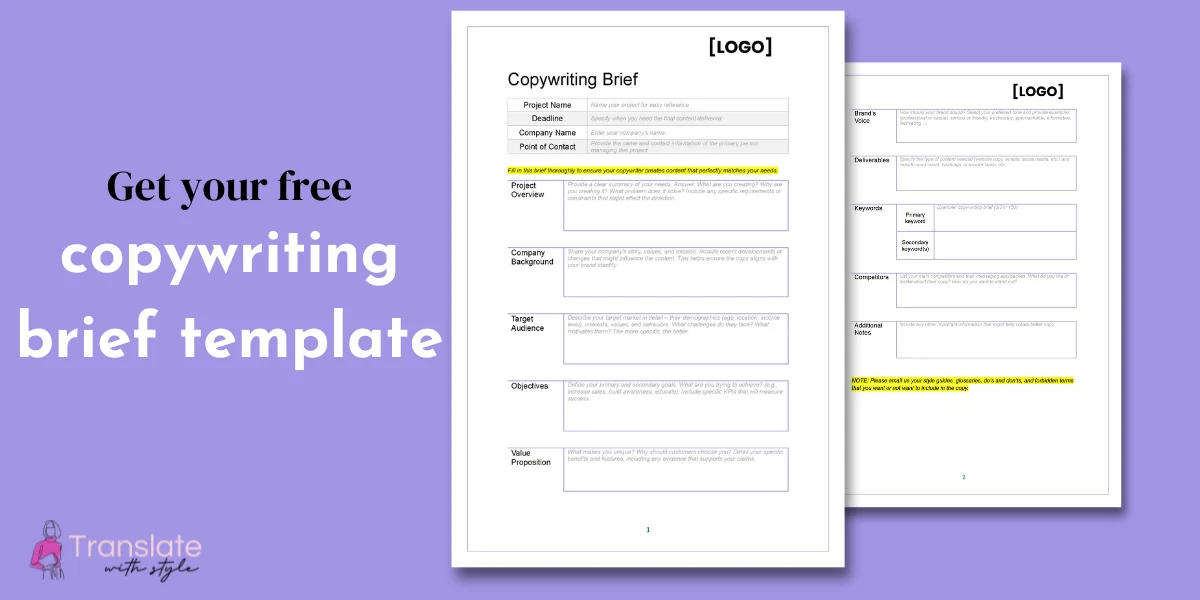Have you ever received copy that completely missed the mark? Or spent hours revising content that should have been right the first time?
The solution might be simpler than you think: a well-written copywriting brief. In this comprehensive guide, we’ll walk you through creating the perfect copywriting brief that will save you time, money, and countless revision cycles.
Don’t forget to download our free copywriting brief template at the end of this guide—it will help you create your own brief quickly and effectively.
What is a copywriting brief?
A copywriting brief is a strategic document that outlines all the essential information needed to create compelling copy for your project.
This document guarantees that everyone, whether part of an in-house team or freelance copywriters, is on the same page regarding the project’s goals, requirements, and expectations.
Why is a copywriting brief important?
Creating a brief might seem like extra work, but it’s an investment that pays off significantly. A well-crafted one prevents miscommunication, reduces revision rounds, and ensures the final copy meets your project objectives.
It also helps copywriters understand your brand voice, target audience, and desired outcomes from the start, making the entire copywriting process more efficient and cost-effective.
How to write a copywriting brief
Certain information should be included in the brief, so we will review it one by one.
1. Project overview
Start your brief with a clear, concise summary of what you need. This section should answer important questions:
- What are you creating?
- Why are you creating it?
- What problem does it solve?
This overview gives copywriters immediate context and helps them understand the project’s scope. Include any specific requirements or constraints that might affect the project’s direction.
2. Company background information
Your company’s story and values are crucial elements that shape the copy’s direction. Include relevant information about your brand’s history or mission.
This context helps copywriters align their work with your brand identity and maintain consistency across all marketing materials. You should also share any recent developments or changes in your company’s direction that might influence the content.
3. Target audience
Understanding your target audience is paramount for creating effective copy. Provide detailed information about your target market’s demographics and psychographics.
Include specific details about age, location, income level, interests, values, and behaviors. The more specific you are about your audience, the better equipped your copywriter will be.
Don’t forget to include information about their pain points and challenges. Understanding what motivates your audience helps create more compelling copy.
4. Objectives
Every piece of copy should have a clear purpose. Are you trying to increase sales, build brand awareness, or educate your audience?
- Define specific, measurable objectives that will help determine the copy’s success
- Include both primary and secondary goals to give your copywriter a complete picture
- Set clear KPIs that will help measure the content’s effectiveness
5. Value proposition
Your value proposition sets you apart from competitors and answers the crucial question: “Why should customers choose you?”
Clearly articulate what makes your product or service unique and valuable to your target audience. Include specific benefits, features, and any supporting evidence that strengthens your claims.
6. Brand’s voice
Your brand’s tone of voice is its personality in written form. Provide clear guidelines about how you want to sound:
- Professional vs. casual
- Serious vs. friendly
- Trustworthy vs. approachable
- Informative vs. motivating
Try to include examples of copy that hit the right tone and any specific language preferences or restrictions your brand follows. Consider creating a style guide with do’s and don’ts for your brand voice.
7. Deliverables and content outline
Different formats require different approaches. Specify whether you need website copy, email campaigns, social media posts, or other marketing materials.
Each format has its best practices and requirements, so be clear about your expectations and technical constraints.
For example, for social media posts, make sure to specify how many posts you need and any platform restrictions on character count. Don’t forget to mention your image guidelines and hashtag strategy—these details can significantly impact the final result.
On the other hand, if you’re creating blog posts, landing pages, or web pages, focus on providing precise word count requirements and target SEO keywords.
Remember to outline your preferences for headings structure, calls-to-action, and technical specifications like metadata.
8. Competitors
Understanding your competitive landscape helps copywriters position your brand effectively. Include information about your main competitors and their messaging strategies.
Share what you like and dislike about their copy and how you want to differentiate yourself in the market.
9. Deadline
Set realistic timelines for first draft submission and review rounds. Don’t forget to account for internal approval processes.
Make sure to clearly communicate your launch date and any intermediate deadlines that need to be met along the way.
Who provides the copywriting brief?
The most effective briefs typically come from marketing managers, project managers, or business owners. These individuals should have a comprehensive understanding of the brand and its goals.
Content strategists can also be valuable contributors to the briefing process, as they understand both strategic goals and content requirements.
Collaboration between different departments often results in the most comprehensive and effective briefs.
Free copywriting brief template
Ready to create your perfect copywriting brief? At Translate With Style, we’ve created a ready-to-use template that will save you time and effort.
Our template provides:
- All essential sections organized in a clear, professional format
- Easy-to-fill fields for your project details
- A clean, structured layout that you can start using right away
- Professional formatting that you can customize to match your brand
[Donwload our free copywriting brief template by making a copy]
Remember, a great brief leads to excellent copy. Take the time to create a thorough brief upfront.
You’ll save time and resources in the long run while getting better results from your copywriting projects.





